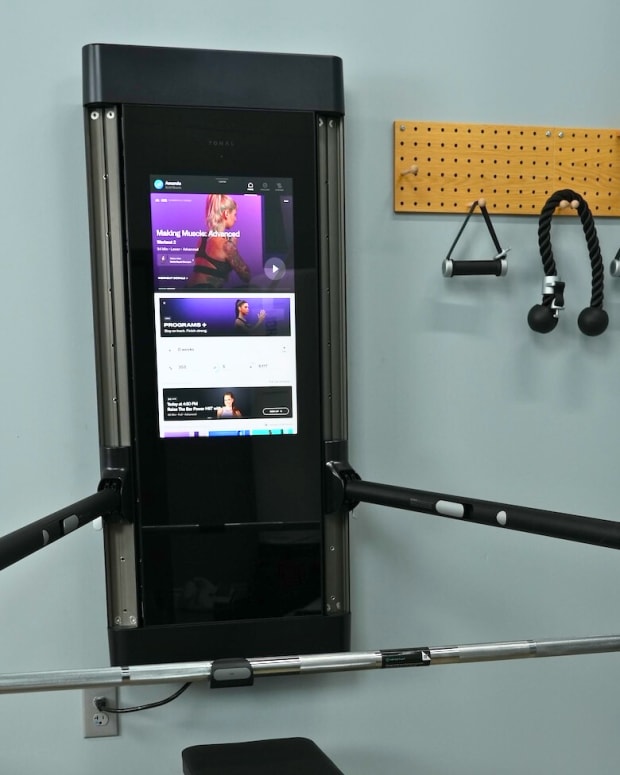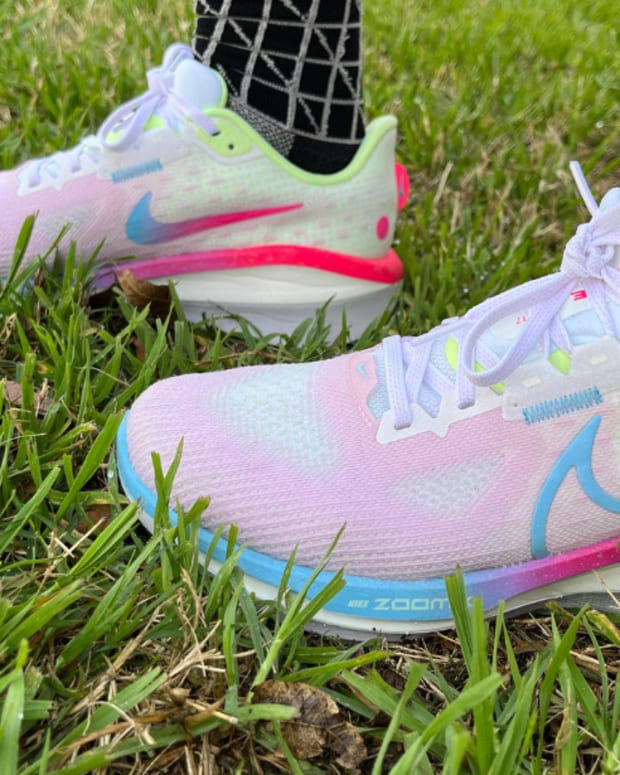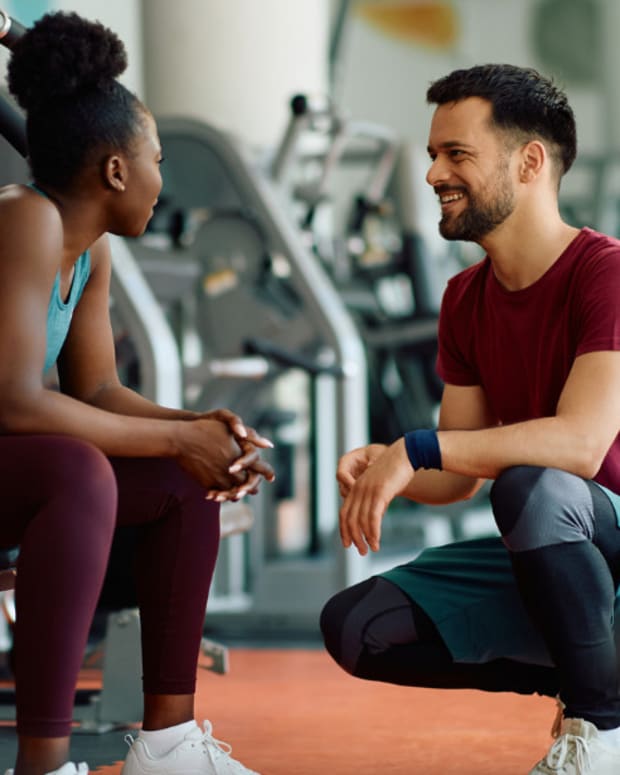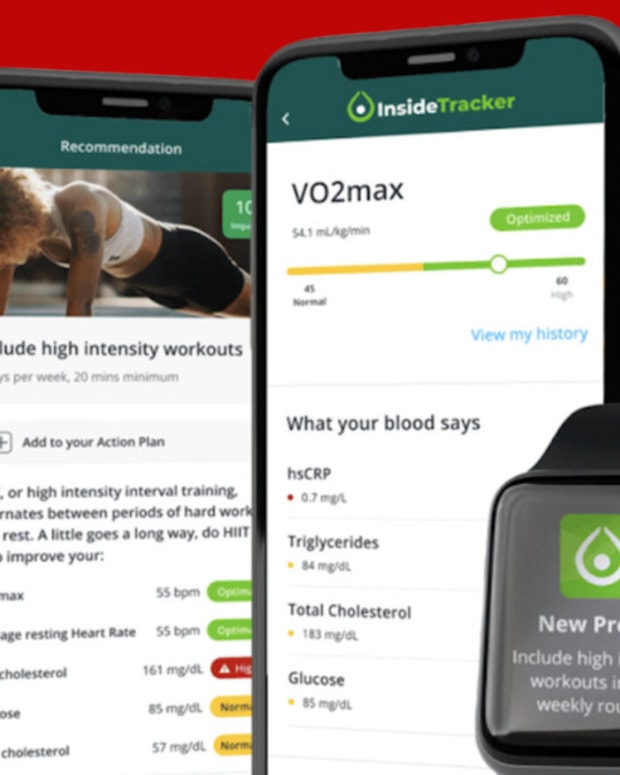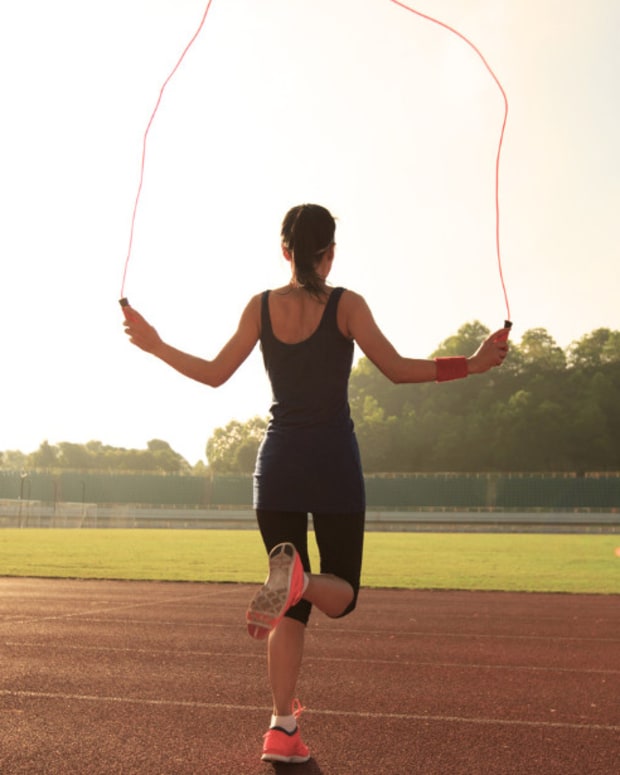The products featured in this article have been independently reviewed. When you buy something through the retail links on this page, we may earn commission at no cost to you, the reader. Sports Illustrated editorial staff are not involved in the creation of this content. Learn more here.
Key Features:
- One to 20-inch arm range and step height
- Contralateral or standard movement patterns
- Variable or fixed resistance options
- Basic display or touchscreen options
Treadmills and ellipticals may currently dominate home gyms, but vertical climbing is becoming increasingly popular. Not only does climbing activate all your major muscle groups, it’s also easy on your joints and can build both muscular and cardiorespiratory endurance, according to PJ Brownell, OPEX CCP Certified Coach and Owner/Head Coach of OPEX Round Rock. The Versaclimber, which was invented in 1981, was the first indoor climbing machine, and it’s still one of the most popular and highly rated.
Initially, there was only one Versaclimber model, but the lineup has expanded to include thirteen options with varying features and types of resistance. In this Versaclimber review, we’ll break down how the cardio machine works, give an overview of each model and discuss who should and shouldn’t opt for the vertical climbing machine. We’ll also compare the Versaclimber to other popular models, like the CLMBR and MaxiClimber, to help you make a decision about which one is best for you.
What Is the Versaclimber?
The Versaclimber is a vertical cardio machine that mimics the movements of outdoor rock climbing. It was created in 1981 by Dick Charnitski, who was trying to bring the benefits of climbing indoors.
It provides a full-body workout since it engages all the major muscle groups in your arms and legs and requires you to keep your core stable as you work through the movements. Essentially, it combines a cardio workout and resistance training in one.
How Does a Versaclimber work?
The Versaclimber is extremely user-friendly. It has two handles and two foot pedals—all you have to do is make the proper adjustments for your height, strap your feet in, grab the handles and start climbing.
Depending on which machine you use, you’ll either move in a isolateral (or standard) movement pattern or a contralateral (or cross-crawl) pattern. The isolateral movement mimics how you would climb up a ladder, with the elbow and the knee maintaining equal distance on each up and down stroke. The contralateral movement pattern mimics how you crawl or run. As you move, the elbow and knee separate on one side, and come closer together on the other side.
During each type of movement, you’re both pushing and pulling and stabilizing your core. This helps activate all major muscle groups, but still keeps your workout low-impact since your hands and feet never leave the machine. “This allows you to use it more frequently with less chances of injury, unlike running (a higher impact exercise) which requires more rest time in between workouts to allow for the lower body to recover,” says Brownell.
Versaclimber Model Overview
There are five main Versaclimber models. They have a lot of similarities as well as some significant differences that set them apart from each other.
Versaclimber H/HP
Specs
- Height: Seven feet 6 inches
- Weight: 63 pounds
- Base size: 36 x 44 inches
- Max user weight: 350 pounds
- Type of resistance: Fixed
- Step height: One to 20 inches
- Arm range: One to 20 inches
- Maximum speed: 255 vertical feet per minute
- Climbing angle: 75 degrees
- Movement pattern: Contralateral
The Versaclimber H/HP is designed for home use. It has a more compact footprint than the other models, with a max height of seven feet and six inches. This model has fixed resistance with one to 20 inch stepping and arm ranges, and the hand grips and foot pedals are adjustable so you can tailor it to your needs.
It operates on a contralateral pattern, and has a basic monitor that displays calories burned, total feet climbed, step height, stroke length, time, distance and feet per minute. You can choose from four pre-programmed modes—standard, race, program or heart rate—or operate the climbing machine manually.
You can purchase the H/HP with or without heart rate monitoring. If you opt for heart rate monitoring, there is an upgrade fee.
Versaclimber LX Model
Specs
- Height: Seven feet 10 inches
- Weight: 145 pounds
- Base size: 43 x 44 inches
- Max user weight: 350 pounds
- Type of resistance: Fixed or variable (zero to 500 pounds)
- Step height: One to 20 inches
- Arm range: One to 20 inches
- Maximum speed: 350 vertical feet per minute
- Climbing angle: 75 degrees
- Movement pattern: Standard or contralateral
The Versaclimber LX is more advanced than the H/HP models. You can still use it in your home gym, but it has a larger footprint and heavier frame that’s designed for commercial use. There are seven LX models and the features depend on which one you pick.
The LX models have variable resistance that ranges from zero to 500 pounds, and you can choose between a standard or contralateral climb pattern. You can also add heart rate monitoring. The ALX models have fixed resistance, with the same upgrade options: contralateral resistance and/or heart rate monitoring.
Regardless of which upgrades you choose (or don’t), the LX models have step and arm ranges from one to 20 inches and a 350-pound max user weight. They’re all seven feet, 10 inches tall.
SM Sport Model
Specs
- Height: 7 feet 10 inches
- Weight: 150 pounds
- Base size: 43 x 46 inches
- Max user weight: 350 pounds
- Type of resistance: Fixed or variable (zero to 500 pounds)
- Step height: One to 20 inches
- Arm range: One to 20 inches
- Maximum speed: 350 vertical feet per minute
- Climbing angle: 75 degrees
- Movement pattern: Contralateral
The SM Sport Model is another commercial-grade piece of fitness equipment. It has the same specs as the LX models, but with one notable difference: You can operate the lower half of the machine independently so it functions as a stair stepper as well as a vertical climber.
The SM Sport is available in both fixed and variable resistance models and with or without Bluetooth. If you opt for the Bluetooth version, you can connect the exercise machine to your smartphone so you can follow along with the free Versaclimber app.
TS Versaclimber
Specs
- Height: 7 feet 10 inches
- Weight: 150 pounds
- Base size: 42 x 45 inches
- Max user weight: 350 pounds
- Type of resistance: Variable (zero to 500 pounds)
- Step height: One to 20 inches
- Arm range: One to 20 inches
- Maximum speed: 350 vertical feet per minute
- Climbing angle: 75 degrees
- Movement pattern: Contralateral
The TS Versaclimber is the brand’s smart machine. Instead of a basic display, it has a Wi-Fi and Bluetooth-enabled touchscreen. You can view real-time metrics, graphs of your progress and compete with other climbers (as long as you’re subscribed to the VC Live fitness app). The touchscreen also allows you to record and save workouts.
This model has a contralateral movement pattern, variable resistance and three handle positions. It has the same one- to 20-inch arm and stepping range as the other models, and a seven-foot, 10-inch height.
SRM Sport Rehab Model
Specs
- Height: 7 feet 10 inches
- Weight: 165 pounds
- Base size: 43 x 50 inches
- Max user weight: 350 pounds
- Type of resistance: Variable (zero to 500 pounds)
- Step height: One to 20 inches
- Arm range: One to 20 inches
- Maximum speed: 350 vertical feet per minute
- Climbing angle: 75 degrees
- Movement pattern: Contralateral
The SRM Sport Rehab model was specifically designed for rehabilitation programs led by clinicians, sports therapists and qualified personal trainers. It operates like the other Versaclimbers, but each component of the machine can also work independently to help isolate and strengthen different muscle groups.
It also comes with an attached seat and orthopedic stops that limit the range of motion in the arms for those recovering from injury, plus two types of hand grips to accommodate various arm, shoulder, chest and back movements.
The display offers real-time voice guidance to help with proper form and movement, and operates via voice feedback.
The Benefits of Working Out With Versaclimber
The user-friendly operation is one of the biggest perks of a Versaclimber, but it offers several health benefits too.
Total body workout
The Versaclimber provides a full-body workout. It activates all the major muscle groups in your upper and lower body, including the arms, shoulders, back, glutes, quads and calves. “This is done by using an upper body push/pull movement and a lower body stepping motion, all while requiring core engagement,” Brownell says.
Low impact
Like a rowing machine, the Versaclimber is also low-impact, according to Brownell. In fact, because your hands and feet don’t leave the grips and pedals, it’s practically zero impact, making it easier on your joints.
Increased range of motion
Some studies suggest that contralateral exercises can also improve range of motion and increase muscle strength, stability and muscle activation. If you want these benefits, make sure you choose one of the models that utilize a contralateral movement pattern.
Better VO2 max
VO2 max is the amount of oxygen your body uses when you’re working out at a high intensity. A high VO2 max is connected to better cardiorespiratory fitness and a longer lifespan. According to an older study, VersaClimbing can increase VO2 max more than treadmill running or rowing.
Who Versaclimber Is Best For
- Those looking for a low-impact cardio exercise
- People who want to combine cardio with resistance training
- Beginners and anyone wanting to get into vertical climbing
Who Versaclimber Is Not Best For
- People who prefer higher impact exercises
- Those shopping for cardio equipment on a tighter budget
- Anyone with limited space or ceilings that are shorter than eight feet
How Versaclimber Stacks Up Against Other Climbers
The Versaclimber was the first vertical climbing machine available to consumers, but now there are other options to choose from. The CLMBR and the MaxiClimber are two of the most popular. Here’s how they compare.
Versaclimber vs CLMBR
The biggest draw of the CLMBR is its connectivity. Most of the VersaClimbers (with the exception of the TS model) have basic displays, but the CLMBR has a large, customizable touchscreen that allows you to choose from about 36 widgets to control which metrics you see.
The touchscreen also connects to the CLMBR app, which gives you access to hundreds of on-demand classes and guided climbs, plus a music library. However, you do have to maintain a monthly (or yearly) membership to the brand’s fitness app to fully utilize the machine. The free version of the app only gives you access to manual climbs and basic metrics.
The CLMBR is both Wi-Fi- and Bluetooth-enabled, so you can connect it to other devices like fitness trackers and headphones. It’s also Alexa-enabled, so you can use voice commands on any compatible device to start, stop and/or resume your workout.
Like many of Versaclimber models, it uses a contralateral movement pattern. You can control the resistance manually—there are 11 levels—and adjust the pedals and hand grips as needed. The CLMBR has a smaller footprint than the Versaclimbers; its base is 35 by 32 inches and it maxes out at seven feet, three inches tall, but it has the same 350-pound maximum weight capacity.
Versaclimber vs MaxiClimber
The MaxiClimber is a budget-friendly vertical climber. It has a more compact footprint than the Versaclimber—it measures 28.3 x 35.82 inches when fully expanded and can fold for storage—but with a less solid construction and a lower maximum weight capacity.
There are two MaxiClimber options: a classic version that supports up to 240 pounds and XL model that has a 300-pound weight limit. The classic MaxiClimber works only with your body weight, while the XL has 12 resistance levels that you can manually control. You can adjust the height on both models, but the handles and foot pedals are fixed.
Both models have very basic displays that show time and calorie burn, but you can download the MaxiClimber app on your phone or tablet to access on-demand workouts and interval timers. The machine isn’t Bluetooth-enabled though, so you can’t connect the app directly—you simply follow along on your phone’s screen as you work out.
Versaclimber FAQs
Does the Versaclimber build muscle?
Because the Versaclimber engages all your major muscle groups, it can build muscle in your arms, legs, back and core. “The full body requirement of the exercise and resistance of the machine also stresses the muscles to cause adaptation and, eventually, muscular strength and endurance increases,” Brownell says, adding that over time this can boost cardiovascular respiratory endurance too.
Which Versaclimber is best for me?
It depends on your needs. The H/HP is a great all-around option for home use, but if you want variable resistance, you may want to upgrade to one of the LX models. If you want a 2-in-1 cardio machine that lets you isolate the lower body, the SRM Sport is the best Versaclimber for you.
Is Versaclimber good for weight loss?
Because the Versaclimber provides a cardio workout, it burns calories, which can help you lose weight. A Versaclimber workout also provides some level of strength training, especially if you dial up the resistance. This can decrease overall body fat while maintaining lean muscle mass. The bottom line? “A good mix of resistance training and aerobic work is ideal for weight loss, and with a vertical climber you can get both of those benefits from one machine,” Brownell says, adding that sustainability and consistency are key for weight loss.
Final Thoughts
The Versaclimber is a well-built machine with many options available to accommodate different types of users. All models offer a low-impact cardio workout that engages all the muscle groups without excessive wear on your joints. Using the Versaclimber regularly may also improve your range of motion and increase your VO2 max more than other types of cardio workouts. If you have the space, and the budget, we think it’s a worthwhile addition to your home gym.
Prices are accurate and items in stock as of publish time.





